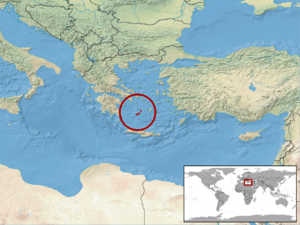Macrovipera lebetinus schweizeri facts for kids
Quick facts for kids Macrovipera lebetinus schweizeri |
|
|---|---|
| Scientific classification | |
| Genus: |
Macrovipera
|
| Species: |
lebetinus schweizeri
|
 |
|
| Synonyms | |
|
|
The Milos viper, also known as the Cyclades blunt-nosed viper, is a type of venomous snake. It belongs to the Viperidae family, which includes many vipers. This special snake lives only on a few islands in Greece. It is a subspecies of the larger Macrovipera lebetinus.
Contents
What's in a Name?
The scientific name for this snake is schweizeri. This name was given to honor a Swiss expert on reptiles and amphibians. His name was Hans Schweizer, and he lived from 1891 to 1975.
How Big is the Milos Viper?
The Milos viper is a medium-sized snake. It usually grows to be about 50 to 70 centimeters (20 to 28 inches) long. This measurement includes its tail. The longest Milos viper ever recorded was almost 98.5 centimeters (39 inches) long.
Where Does the Milos Viper Live?
This unique snake is found only on certain Greek islands. These islands are part of the Cyclades Archipelago in the Aegean Sea. You can find the Milos viper on Milos island. It also lives on three smaller islands nearby: Siphnos, Kimolos, and Poliaigos.
Why is the Milos Viper Endangered?
The Milos viper is an endemic species, meaning it lives only in this small area. Because of this, it is considered an endangered animal. The IUCN Red List of Threatened Species lists it as "Endangered" (EN). This means it faces a very high risk of disappearing forever.
- Small Home: The total area where these snakes live is very small. It's not much bigger than 100 square kilometers (39 square miles). They are only found on four small islands.
- Habitat Loss: Their homes are shrinking and getting worse. This happens because of human activities.
- Fewer Snakes: The number of adult Milos vipers is going down. People sometimes harm them because they are afraid of snakes. Also, some snakes are illegally collected.
Experts checked on the Milos viper's status in 2009. To help protect it, the snake is also listed under the Berne Convention. This agreement helps protect wildlife in Europe.
About the Milos Viper's Venom
The Milos viper is a venomous snake. This means it can inject venom if it bites. An old book called The Snakes of Europe mentions this snake. It says that the bite of this viper is likely very serious. It might be as serious as the bite of its relative, the Daboia, which is found in India. It's important to remember that all wild snakes should be observed from a safe distance.

